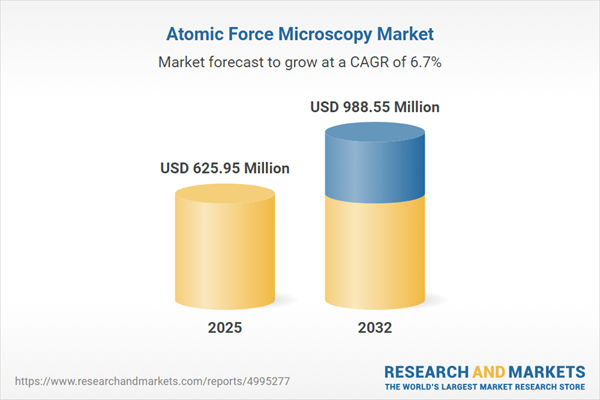Speak directly to the analyst to clarify any post sales queries you may have.
The atomic force microscopy market is evolving rapidly, driven by technological innovation, shifting global supply chains, and a growing need for high-precision surface analysis across research and industry. Senior decision-makers must navigate advancing instrumentation, digital integration, and changing trade conditions to remain competitive in this dynamic sector.
Market Snapshot: Atomic Force Microscopy Market Size and Growth
The Atomic Force Microscopy Market grew from USD 588.63 million in 2024 to USD 625.95 million in 2025. It is forecasted to expand at a CAGR of 6.69%, reaching USD 988.55 million by 2032. This growth reflects increasing adoption of atomic force microscopy solutions in advanced research, manufacturing quality control, and global supply chains, supported by ongoing hardware and software developments.
Scope & Segmentation of the Atomic Force Microscopy Market
- Offering
- Hardware: Atomic Force Microscope, Force Sensor, Scanning Probe
- Services: Maintenance & Consulting, Testing & Analysis
- Software: Analysis Software, Image Processing Software
- Mode of Operation
- Contact Mode AFM, Non-Contact Mode AFM, Tapping Mode
- Grade
- Industrial-Grade, Research-Grade
- Application
- Biology & Life Sciences, Material Science, Nanotechnology, Semiconductor
- End-User
- Academic & Research Institutions, Automotive & Aerospace, Chemical, Pharmaceutical & Biotechnology, Semiconductor & Electronics
- Sales Channel
- Offline, Online
- Region
- Americas: United States, Canada, Mexico, Brazil, Argentina, Chile, Colombia, Peru
- Europe, Middle East & Africa: United Kingdom, Germany, France, Russia, Italy, Spain, Netherlands, Sweden, Poland, Switzerland, United Arab Emirates, Saudi Arabia, Qatar, Turkey, Israel, South Africa, Nigeria, Egypt, Kenya
- Asia-Pacific: China, India, Japan, Australia, South Korea, Indonesia, Thailand, Malaysia, Singapore, Taiwan
- Key Companies Profiled
- Bruker Corporation, Keysight Technologies Inc., Park Systems Corporation, Veeco Instruments Inc., Oxford Instruments plc, Hitachi High-Technologies, Nanosurf AG, JEOL Ltd., AFMWorkshop LLC, Nanonics Imaging Ltd., Attocube Systems AG, CSInstruments, Molecular Vista Inc., RHK Technology, Nanomagnetics Instruments Limited, NT-MDT Spectrum Instruments, Nearfield Instruments B.V., Novacam Technologies, DME Scanning Probe Microscopes, Nanoscan Ltd, Unisoku Co. Ltd. by Tokyo Instruments Inc., Nanoscience Instruments, Horiba Ltd.
Key Takeaways for Decision-Makers
- Market demand is influenced by ongoing advances in probe technology, image processing software, and integrated system architectures, supporting research and industrial innovation.
- Integration of atomic force microscopy with complementary techniques, such as Raman spectroscopy and electron microscopy, is fostering multidisciplinary solutions and deeper analytics.
- Automated scanning, machine learning, and digital analysis have reduced manual intervention, accelerating R&D cycles and improving cost efficiency for end users.
- Regional supply chain adjustments, including nearshoring and supplier diversification, are mitigating disruption from tariff and trade policy changes.
- Service and consulting segments are growing as organizations require optimization of uptime and access to specialist technical expertise.
- Vendors are differentiating through modular system designs and cloud-based analytics, enhancing adaptability to evolving operational needs.
Evaluating Tariff Impact on the Atomic Force Microscopy Market
The introduction of new tariffs in the United States from 2025 is shifting global supply chain strategies within the atomic force microscopy sector. Companies are re-assessing sourcing, manufacturing, and contract agreements to address increased costs for specialized components. Some firms are investing in regional manufacturing and vertical integration, while software and service providers emphasize broader hardware compatibility and adaptive service offerings to retain competitiveness.
Methodology & Data Sources
This report leverages a rigorous mix of primary interviews with manufacturers, service providers, and end users, combined with secondary research including technical publications, patent filings, and industry white papers. Quantitative inputs are cross-validated through surveys and financial disclosures to ensure data reliability and comprehensive coverage.
Why This Report Matters
- Enables strategic planning and risk mitigation by illuminating current market landscape, supply chain trends, and adoption drivers.
- Supports investment and procurement decisions with actionable segmentation, regional analysis, and competitive profiling.
- Equips leadership with practical insights for navigating regulatory shifts and capitalizing on emerging technology opportunities.
Conclusion
The atomic force microscopy market is experiencing robust transformation, shaped by technological progress, regional realignment, and evolving customer requirements. Informed strategic action is essential for sustained growth and maintaining competitive edge in this industry.
Additional Product Information:
- Purchase of this report includes 1 year online access with quarterly updates.
- This report can be updated on request. Please contact our Customer Experience team using the Ask a Question widget on our website.
Table of Contents
3. Executive Summary
4. Market Overview
7. Cumulative Impact of Artificial Intelligence 2025
Companies Mentioned
The companies profiled in this Atomic Force Microscopy market report include:- A.P.E. Research
- AFMWorkshop, LLC
- Attocube Systems AG
- Bruker Corporation
- CSInstruments
- DME Scanning Probe Microscopes
- Hitachi High-Technologies
- Horiba, Ltd.
- JEOL Ltd.
- Keysight Technologies Inc.
- Molecular Vista, Inc.
- Nanomagnetics Instruments Limited
- Nanonics Imaging Ltd.
- Nanosurf AG
- NT-MDT Spectrum Instruments
- Oxford Instruments plc
- Park Systems Corporation
- RHK Technology
- Veeco Instruments Inc.
- Nanoscan Ltd
- Unisoku Co., Ltd. by Tokyo Instruments, Inc.
- Nearfield Instruments B.V.
- Novacam Technologies
- Nanoscience Instruments
Table Information
| Report Attribute | Details |
|---|---|
| No. of Pages | 194 |
| Published | November 2025 |
| Forecast Period | 2025 - 2032 |
| Estimated Market Value ( USD | $ 625.95 Million |
| Forecasted Market Value ( USD | $ 988.55 Million |
| Compound Annual Growth Rate | 6.6% |
| Regions Covered | Global |
| No. of Companies Mentioned | 25 |









